Summer Citrus Soap Recipe With a Natural Essential Oil Blend

This homemade summer citrus soap recipe contains a citrus inspired natural essential oil blend of peppermint, orange and lemongrass. Formulated to be both cleansing and conditioning, this natural soap works great at tackling sweat and grime without over drying skin. Discover how to make this cold process soap for your summer skin care routine. Plus get ideas for using the finished soap bars as embeds in an easy melt and pour soap DIY.
Summer Soap with Citrus Essential Oils
Because I have hard water and dry skin throughout the winter months, I’ve been formulating a lot of high conditioning/low cleansing soap recipes. However with the arrival of spring and the heat of summer on the way, I thought I’d create a new homemade soap recipe with extra cleansing power. After all, real women sweat — even if we don’t like people to know about it.
Recently I’ve been dating a guy originally from the deep South. His name is Greg. He found his way to Roanoke by way of Florida on to Georgia then South Carolina. Now he’s here. He’s a carpenter now by trade. So he tends to get dirty. As such, he was super psyched about me making a homemade soap that tackles tough grit, grime and sweat. Me? well I’m psyched he actually uses homemade soap and not some surfactant infused body wash. (If you’re a soapmaker then you understand my dilemma entirely.)
Therefore, I create this amazing DIY citrus soap. Greg calls this citrus soap recipe the Florida Gators soap. To be quite frank, I don’t follow sports. And I have absolutely no idea what sport the Gators play. What I do know is that orange is their color. And seeing as how Florida is the sunshine state, Greg thought it fitting to scent this summer soap with a blend of orange and citrus essential oils.
Where my sports education is lacking however, I was properly schooled on Jacksonville, where Greg attended college. The culture of which was all readily explained via a Katt Williams comedy show at the Florida Theater.
But I digress. I made a sweet summer citrus soap recipe with natural essential oils — which is the point of this entire post. Greg helped me make this DIY summer soap and rather enjoyed the process. (Hooray! It’s always nice to have a new partner in crime, isn’t it? Also my dog loves Greg and to me, that kind of says everything.)
So, as they like to say, without further ado, here is my summer citrus soap recipe for your soapmaking pleasure. I hope you enjoy it!
Citrus Soap Recipe with Natural Essential Oils
This citrus soap recipe contains an invigorating essential oil blend of peppermint, orange and lemongrass. In addition to its fabulous summer soap scent, this cold process soap also cleanses and conditions skin. I’ve included the percentage of the oils used to make this citrus soap should you decide to resize the batch. (Keep in mind that you will need to run this cold process soap recipe back through a lye calculator to ensure that the amount of water and lye is correct if resized. You can learn how to resize a cold process soap recipe here.)
Ingredients to Make Natural Citrus Soap with Orange and Lemon:
These are the natural ingredients you will need to make this homemade citrus soap recipe:
Soap Making Oils and Fats
The fats, or soap making oils and butters, are used to create the unique properties found in this citrus cold process soap recipe. Here are the ones I chose to formulate my citrus essential oil soap:
- .8 oz. castor oil (5%): Not only does castor oil add skin conditioning properties to soap, it also helps to create a stable lather that is low, dense, and creamy in texture.
- 4.8 oz. refined coconut oil (30%): Coconut oil is used in this citrus cold process soap to boost the lather. It also helps to create harder homemade soap bars. I used a higher percentage of coconut oil to formulate my DIY citrus soap due to the high volume of mango butter also included in the recipe.
- 2.4 oz. jojoba oil (15%): Jojoba not only helps the bubbles produced by your citrus soap last longer, but it also helps to condition skin.
- 2.4 oz. mango butter (15%): The fatty acid profile of mango butter gives this orange, citrus scented soap extra conditioning properties to hydrate skin. It also helps to harden the bars.
- 5.6 oz. pomace olive oil (35%): I love using pomace olive oil as it’s more affordable than the virgin version. Additionally, pomace olive oil tends to trace faster than the other types available. It also helps to create a hard bar with a gentle, stable lather. Like some of the other ingredients used to make this orange citrus soap recipe, it also has moisturizing and skin conditioning properties.
Lye-Water Mixture
The lye, also known as an alkali, combines with the soap making fats to make soap. When diluted with water and then mixed with the oils and butters called for in this citrus cold process soap recipe, the ingredients then go through what is called saponification. You need to use the correct amount of lye when making cold process soap. The amount used is determined by a lye calculator. Otherwise, you may end up with a soap that is too soft or that is lye heavy. (Learn how to use a lye calculator here.)
Here is the amount of water and lye need to recreate this summer cold process soap recipe:
- 4 fl. oz. distilled (or filtered) water
- 2 oz. lye/sodium hydroxide
Ingredients to Add at Trace
Once you mix the fats and alkali to create a soap batter, these are the ingredients that you want to add when the soap reaches a light trace:
- 1/8 teaspoon red iron oxide powder
- 1/8 teaspoon yellow oxide powder
- .15 oz. peppermint essential oil
- .15 oz. 5-fold orange essential oil
- .25 oz. blood orange essential oil
- .35 oz. lemongrass essential oil
- Dash of petitgrain essential oil
Cold Process Citrus Soap Notes
Following is additional information you need should you decide to resize this recipe. You can use this information to resize my summer citrus soap recipe using a lye calculator. Or to make changes to the super fat or water percentage.
- As my summer citrus soap recipe doesn’t yield a particularly hard bar, I used a steeper water discount than I normally would to compensate. The water weight for this recipe is 25% of the oil weight. If you’d like to make a hot process soap with citrus essential oils, then you can use full water with this recipe. Alternately, you can also increase the water if desired. In this instance, I advise that you add either a teaspoon of salt or sodium lactate to harden this cold process soap.
- Additionally, the super fat used to make this orange citrus soap is 6%.
- While the total essential oil weight is 5% of the oil weight for this cold process recipe. This is based off the recommended usage for these essential oils in cold process soap.
You can learn more about using a lye calculator to adjust a homemade soap recipe or discover how to make a custom cold process soap recipe here.
Cold Process Soap Making Tools and Equipment
In addition to the ingredients needed to make orange soap, you will also need several tools and various equipment to get started. Begin by gathering the following to complete this soapmaking project:
- Digital scale: A scale is used to weigh all of the ingredients for this summer soap recipe and the essential oil scent blends.
- Digital laser thermometer: You need a thermometer so you can accurately judge the temperature of both the lye-water and soap making oils before you mix them together.
- Immersion blender: Also known as a stick or hand blender, this tool makes it quick and easy to mix your scented summer soap and bring it to trace.
- 6-cavity silicone mold: I used a simple cavity mold to mold the soap bars. As this mold is silicone, there’s no need to prep or line the mold.
- Goggles: Protective eyewear will prevent damage to your eyes if the soap batter or lye-water is splashed or spills.
- Gloves: Nitrile gloves also protect hands from accidental burns that can occur when working with lye.
- Pitchers and measuring cups: You’ll need a heat safe pitcher or container to mix your lye-water in as well as to weigh out the soap making ingredients.
- Large mixing spoons: I use a long plastic spoon, like the wooden ones but plastic, to mix my lye water. I also use a heavy duty metal spoon to scoop out semi-solid oils and butters.
- Spatula: A spatula makes it easy to get all of the soap out of the pot and into the prepared soap mold. It is also used to smooth down the layers and tops of soap.
You should also take necessary safety precautions when working with lye. If you are unfamiliar with making cold process soap, I recommend this tutorial on how to make soap to get you started. I also offer several beginner soap recipes to try before attempting this soap. These include my beginner soap recipe as well as my palm free olive & babassu soap recipe.
How to Make Citrus Soap
These are the steps to follow to make cold process citrus soap with orange essential oils:
1. Begin by preparing the lye solution for my natural citrus soap recipe. To do this, measure out the distilled water into a heat safe container. In a separate container, weigh out the lye called for in the recipe. Then pour the lye into the water – I recommend a well ventilated area – and mix until the lye has completely dissolved. Now set the lye-water solution aside in a safe location to cool.
2. While the lye solution cools, weigh out the soapmaking oils and the mango butter. Combine in a stainless steel pot. Then gently heat the oils and mango butter on the stove over low heat just until the mango butter has melted.
3. Remove the soapmaking oils from heat and allow to cool.
4. In the meantime, measure out the colorants for my summer citrus soap recipe. Then weigh out the essential oils and combine in a small glass beaker.
5. Once the oils have reached 90°-95°F you are ready to make soap.
6. Check the temperature of both the soapmaking oils and the lye solution before you begin. Both of these ingredients should be within ten degrees of one another.
7. Now add the red iron and yellow oxide colorants to the soapmaking oils. Mix briefly with an immersion blender to incorporate the colorant throughout the oils.
8. Next, pour the lye solution into the soapmaking oils and mix with the immersion blender until you reach a light trace. You’ll know you’ve reached trace when you drag the blender through the soap batter and it leaves a visible trail behind. It’s a little like pudding.
9. Add the lemongrass and orange oils to the soap batter for a summer soap scent. then continue mixing until thoroughly combined.
10. Once you bring the soap to a medium trace, pour the soap into each of the cavities of your mold. Then gently cover the soap with plastic wrap or parchment paper.
11. Set the soap aside for 24-48 hours. After this time you can unmold your summer citrus soap bars.
12. Allow your homemade citrus soap bars to cure for four to six weeks in a cool, dry location. After that, your homemade soaps are ready to use.
Melt and Pour Citrus Soap DIY
Once your cold process summer citrus soaps have cured, you can get creative! I was able to use one bar of my natural citrus soap to create embeds. I then used those embeds make three round, orange slice soaps using a clear melt and pour soap base.
If you’d like to make your own orange soaps that resemble orange slices, then follow these steps:
1. Cut one bar of the summer citrus soap in half lengthwise. Then cut each half into triangles. Set aside.
2. Now cut a block of clear melt and pour soap base into chunks. (The amount you use will depend on how many soaps you plan to make as well as the size of your mold’s cavities.) Combine in a Pyrex measuring cup or another heat safe container. Melt in the microwave in 20-30 second increments, stirring after each heating.
3. Once the clear soap base has completely melted, add a yellow liquid soap colorant to the base until you reach the desired color. (Or you could also use a liquid blue soap colorant. Go Gators!)
4. If desired, add a fragrance or essential oil of your choice. (I used blood orange essential oil for this step at 2% of the soap weight.) Then stir the soap to incorporate the fragrance evenly throughout the soap.
5. Now pour a small amount of the melt and pour soap into three cavities of a round silicone mold. Then spray the soap with isopropyl alcohol to remove any air bubbles.
6. Next, place the triangle soap embeds you made from the summer citrus soap into the soap you just poured. Arrange the embeds as desired.
7. Once the melt and pour soap base is firm — you don’t want your embeds to shift — spray the soap again with isopropyl alcohol. Then pour the remaining melt and pour soap base into the same three cavities of the mold. Fill the cavities to the top of the mold, then spray again with isopropyl alcohol to remove any air bubbles.
8. Once the DIY orange soaps have fully hardened, remove the soap slices from the mold.
9. Then, if desired, you can bevel the edges of the soap using a potato or vegetable peeler.
10. Now simply wrap your soaps tightly in food service film to store until use.
Citrus Soap FAQ
What is citrus soap?
Citrus soap is a soap made using citrus essential oils or citrus based ingredients. This soap can be made either by using a melt and pour soap base or via the cold process soap making method. Examples of citrus soaps include soaps made with apple fruit powder, key lime peel powder, or orange peel powder. They may also include a soap formulated using orange or lemon essential oil, or some other variation of citrus essential oils.
What types of citrus essential oils are used to make soap?
Citrus oils make wonderful summer soap scents. Some common citrus essential oils that are used to make this type of summer soap include the following:
- Sweet orange oil
- Steam distilled lemon essential oil
- Grapefruit essential oil
- Lime peel essential oil
- Tangerine oil
- Mandarin oil
- Steam distilled neroli oil
- Bergapten free bergamot oil
- Blood orange essential oil
- Petitgrain essential oil
- Yuzu essential oil
When purchasing citrus essential oils to make soap, keep in mind that steam-distilled essential oils have a longer shelf life than those that are cold-pressed.
What is citrus soap good for?
Natural citrus soap that contains citrus essential oils or botanical ingredients provides a number of skin care benefits. Here are some of the benefits to using citrus essential oils in cold process soap:
- Most citrus essential oils have strong anti-inflammatory properties. Therefore they can help to soothe irritated skin.
- Orange essential oil is naturally antibacterial. This not only helps to remove bacteria from skin, but it can also aid in the prevention of acne.
- Citrus essential oils contain antioxidants. As such, they can help to fight aging when used as part of your daily skin care routine. This is one reason why Vitamin C serums are now so popular. Just like your favorite serum, soaps made with citrus help to rejuvenate skin by neutralizing free radicals.
- Likewise, citrus essential oils also help to brighten skin and even out skin tone. Not only can they help with hyperpigmentation, but they also help fade acne scars.
- In addition to the antioxidants found in orange essential oil, they also contain vital nutrients and minerals believe to assist with new cell growth.
- When used for aromatherapy, the natural scent of citrus oil can help lift your mood.
- Like other essential oils that have either a warming or cooling effect on skin, orange oil helps to improve circulation.
Is orange soap good for acne?
Orange essential oil is beneficial when used in soap if you have acne prone skin. Because this oil has antiseptic and antibacterial properties, it is effective at helping to prevent acne and its reoccurrence. In addition, orange oil can also help to reduce the appearance of pores and calm facial inflammation. Additionally, the citric acid from fruit also helps to maintain the correct PH level for your skin.
Is citrus good for your face?
As citrus fruits are naturally rich in vitamin C, they make an excellent ingredient for face care. The vitamin C content helps to combat the effects of aging, even skin tone and tackle hyperpigmentation and age spots.
Does citric acid tighten skin?
Citric acid, which is often found in the citrus fruit powders used to make soap, does help to tighten skin and reduce the appearance of pores. This is due to the astringent properties that citric acid possesses.
Is it safe to use citrus essential oils to make soap?
As homemade soap is a wash-off product, you don’t need to worry about the citrus essential oils you use to make soap causing photosensitivity. However, as someone who is fair skinned, I definitely recommend using sunscreen regardless. After all, sunburns are no fun. Alternately, you can also choose to use oils that aren’t photo-toxic, such a steam distilled lemon or sweet or blood orange oil.
How long does citrus soap last?
Soap made using the cold process soap making method tends to have an extensive shelf life of one to two years. However, it is possible that your citrus cold process soap may last long than this. As long as the oils used to make the soap don’t go rancid, then this soap is fine to use for as long as you don’t see what are known as dreaded orange spots.
If you are making melt and pour citrus soap, then expect a shelf life of up to one year.
For best results, I recommend that you store your orange soaps in a cool, dry location until use. You should also ensure soaps are well drained between use. This helps the product to last longer.
Homemade Summer Soap Recipes
If you like my summer citrus soap recipe with natural lemongrass and orange essential oils, then you may also want to try some of my other summer inspired homemade soap recipes. These include:
- Blood orange soap recipe: Made using blood orange essential oil and orange powder, this summer inspired soap is painted with mica for a fun, fresh appearance.
- DIY Seashell Soap: This easy melt and pour soap recipe is filled with seashell soap embeds that remind users of summer beach trips.
- Aloe Soap Recipe: This cold process soap recipe is made with aloe vera gel. So, its the perfect homemade soap for summer when you need to soothe summer sunburns.
- Calendula Soap Recipe: Put your summer flowers to good use by creating a calendula oil infusion to make homemade soap.
- Natural Shaving Soap Recipe with Lanolin: Summer means bare legs! That means shaving more than ever. This shaving soap is up for the task!
- Yogurt & Banana Soap with Flax Seed Oil: Due to the yogurt content found in this cold process summer soap recipe, it’s also great for sunburned skin.
- Green Apple Soap Recipe: Formulated with green tea and apple powder, this soap helps to rejuvenate and exfoliate skin with natural occurring plant acids. Top it with your summer botanicals for a fun look.
- Pine Tar Soap Recipe for Problem Skin: Pine tart soap is great for summer. Not only does it help to repel insects, but it is also beneficial if you have skin irritation from summer plants and insect bites.
- DIY Sunflower Soap: This easy melt and pour soap recipe is shaped like your favorite late summer flowers!
- Watermelon Soap Recipe: Another wonderful summer soap, this cold process soap recipe is similar to many citrus soaps in that it contains vitamin C rich watermelon fruit powder.
Looking for even more summer soap making ideas similar to my citrus soap recipe? Then be sure to explore all my cold process soap recipes here. Alternately, you can also find my original melt and pour soap recipes here.
Or, check out these 12 summer skin care recipes with camellia seed oil.
For more homemade bath, body, beauty and soap recipes, be sure to find and follow Soap Deli News across all of your favorite social media platforms. You can find and follow me on Facebook, Twitter, Blog Lovin’, and Instagram. Alternately, you may also for future updates, DIY projects and recipes.
Enjoyed the project?
Suggested materials:
- Castor oil
- Coconut oil
- Jojoba oil
- Mango butter
- Pomace olive oil
- Distilled water
- Lye
- Oxide powders
- Essential oils
The author may collect a small share of sales from the links on this page.

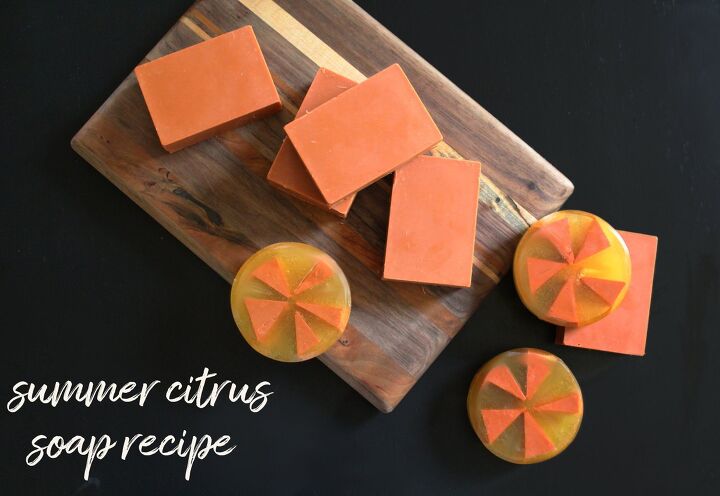








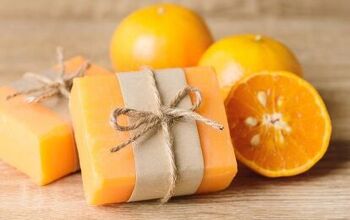
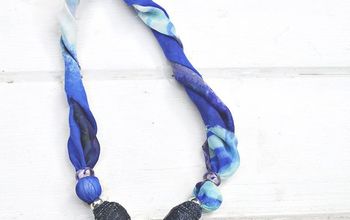



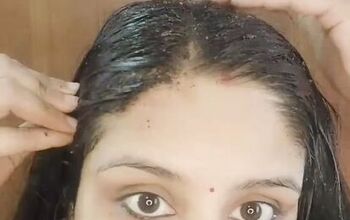


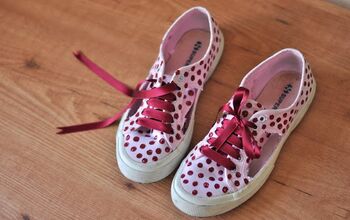
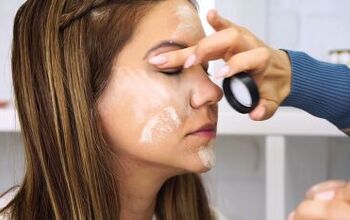





Comments
Join the conversation